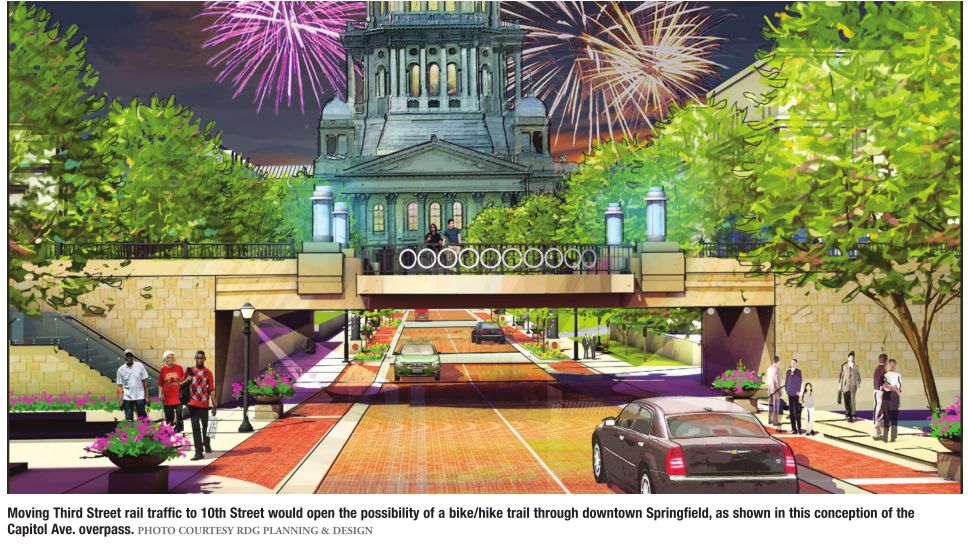
Uncertainty abounds as feds throw in new option, funding still unclear
RAIL | Patrick Yeagle
Springfield’s long-awaited railroad consolidation study calls 10th Street the best option, but the project’s fate remains murky as the federal government examines a new alternative and the availability of funding.
Prepared by Hanson Professional Services of Springfield with a summary released by the City of Springfield on its website last week, the consolidation study analyzed costs, safety, noise, vibration, environmental impact and other variables associated with future railroad expansion plans. The Union Pacific Railroad, which runs freight and passenger trains along Springfield’s Third Street corridor, announced in 2009 that it would significantly increase freight traffic in coming years. The announcement came around the same time that the federal government unveiled plans for a high speed rail line connecting Chicago with St. Louis via Springfield, prompting Springfield and Sangamon County officials to push for a study of rail consolidation options.
The Hanson study recommends shifting all rail traffic on the Third Street rail corridor to an expanded 10th Street corridor and adding five underpasses or overpasses – called grade separations – to 10th Street intersections. The recommended plan would also add grade separations where Ash Street and South Grand Avenue meet the 19th Street rail corridor. The Third Street corridor would be eliminated, and a quiet zone would be enacted along both remaining corridors.
According to the Hanson study, shifting Third Street rails to 10th Street would require the least sacrifice and yield the greatest benefits.
“It has the second lowest traffic delays, lowest crash frequency, lowest train horn noise, second lowest number of displacements, lowest number of access changes and lowest total cost,” Hanson says in its study
report. “It fulfills the project purpose and need with the lowest total cost while minimizing environmental impacts. This alternative does not cause additional noise and vibration impacts to the Medical District, or a severance to their long-term plans. Impacts to historic structures will be minimized and no … impacts to parks [are] anticipated.”
Hanson notes that the recommended plan would displace fewer people than other plans, and it has the most community support. A survey conducted by Hanson showed 47 percent of 220 Springfield respondents favored consolidating both the 19th Street and Third Street rails to 10th Street, while 42 percent favored consolidating only the Third Street rails to 10th Street. Eleven percent of respondents favored expanding the Third Street corridor to two tracks.
The recent introduction of an additional option by the Federal Railroad Administration adds a new level of complexity and uncertainty. Mark Yachmetz, associate administrator of railroad policy and development for FRA, announced in an Aug. 9 meeting in Springfield with city and county officials that FRA is also considering a plan to move freight rail traffic from Third Street to 10th Street while keeping passenger rail traffic on Third Street.
On Aug. 12, FRA Administrator Joseph Szabo addressed via email to Illinois Times the notion that a statewide study of the entire high speed rail project would nullify the local study.
“It is critical to have a deliberative record that does not prematurely reach any conclusion,” Szabo said. “By incorporating the local analysis into the full corridor study, it protects taxpayers from litigation that could cost many thousands in legal fees, protects the city’s ability to obtain federal funding, and prevents delays in implementing solutions to Springfield’s traffic and safety problems. By consolidating the studies, Springfield’s official decision on rail consolidation will be advanced 18 months sooner than if the two studies were concluded separately.”
Szabo said FRA would “show deference to responsible community wishes as long as they are consistent with federal laws and regulations for the project’s purpose and need.
“FRA is committed to an open process with the Springfield community to ensure the record reflects a clear understanding of the city’s needs, concerns and desires,” he said. “In addition, FRA has added a fourth alternative for public input and we want to hear what the public thinks about it, thus ensuring an open process.”
Mayor Michael Houston called the new option “the worst possible outcome for the City of Springfield,” saying it could jeopardize the entire consolidation plan because it would remove the possibility of using federal high speed rail funding for consolidation.
“We have been working for years to consolidate rail traffic on a preferred corridor so that proper mitigation efforts could eliminate grade crossings and allow vehicles and trains to move smoothly though our city,” Houston said in an Aug. 10 press release. “This proposal negates every bit of work we have done, including the [environmental impact study] completed by Hanson Professional Services.”
“This fourth alternative should not even be on the table,” Houston continued. “Allowing Amtrak to run passenger trains on Third Street will continue to produce congestion and traffic delays in the core center of our city. And, it would not be conducive to expanded development in the medical district. We would get the worst decision that could be possibly imagined.”